Hidden Bailey to Aoya Gate
On the fateful day when the Siege of Osaka came to its tragic end, a silent story unfolded on the castle’s northern side—one that history books rarely recount.
This lesser-known narrative lingers in the quiet remnants of Osaka Castle’s northern area: the “Hidden Bailey,” a cunning defensive structure masterminded by Toyotomi Hideyoshi; the “Inscribed Stone Square,” where the weight of centuries is etched in stone; and the “Yamazatomaru Turret,” a place where a mother and child made their final, heartbreaking choice. These are not just ruins—they are echoes of the Sengoku era, preserved in solemn stillness for those who know where to look.
In this fourth installment of our Osaka Castle Series, we explore the castle’s northern front—a key stronghold often overlooked by typical sightseeing routes. From the strategic genius of Hideyoshi’s fortress design to the gates and stones that bore witness to the end of an age, this corner of the castle offers powerful, untold dramas waiting to be discovered.
Join us on this journey and uncover a side of Osaka Castle that you may think you know—but have never truly seen.
Hidden Bailey (Kakushi Kuruwa)
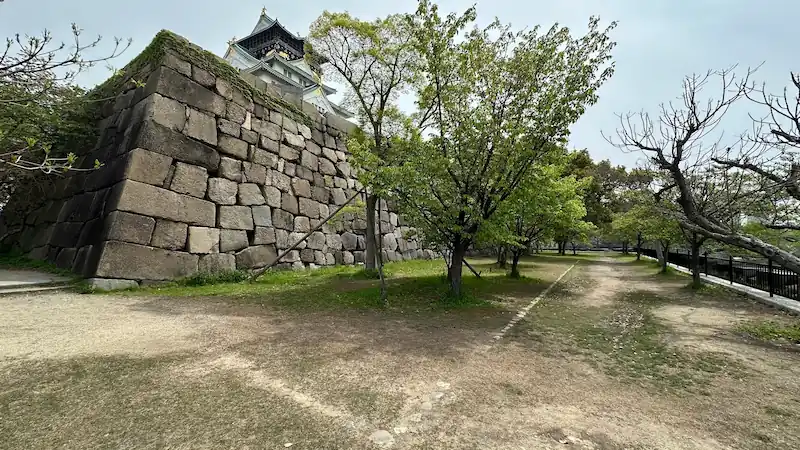
🏛 Overview
Tucked away in the northwest section of Osaka Castle lies the “Hidden Bailey” (Kakushi Kuruwa)—a defensive structure that is often overlooked by tourists, yet showcases the brilliant military mind and architectural mastery of Toyotomi Hideyoshi. True to its name, this “hidden” enclosure was strategically placed in a location difficult for enemies to detect, functioning as the “final line of defense” against intruders.
Hideyoshi’s castle-building strategy wasn’t just about fortification—it was a sophisticated system of invisible design intended to manipulate enemy movements. The Hidden Bailey is a perfect example of this genius. Its angled stone walls and walkways are meticulously crafted to limit visibility and redirect paths, revealing the tactical brilliance behind every stone and turn.
Today, the area has been preserved as a peaceful forested corner of the castle grounds. It’s a rare spot where you can truly feel the tense atmosphere of the Sengoku period. With few tourists around, it’s an ideal retreat for those who wish to quietly reflect on the Toyotomi legacy.
| Year Built | Late 16th century (Azuchi-Momoyama period) |
|---|---|
| Builder | Toyotomi Hideyoshi |
| Structure/Features | Secluded bailey with angled stone walls and narrow pathways designed to control enemy movement and visibility |
| Renovation/Restoration | Preserved in its original state; minimal restoration to maintain historical integrity |
| Current Status | Accessible to the public; remains a tranquil area within Osaka Castle Park |
| Destruction/Damage | Survived multiple conflicts; remains intact |
| Cultural Property Designation | Not individually designated; part of Osaka Castle Park’s historical landscape |
| Remarks | Served as a final line of defense; exemplifies Hideyoshi’s strategic military architecture |
🗺 Location:
1-1 Osakajo, Chuo-ku, Osaka-shi, Osaka Prefecture
🚶 Access:
Approx. 3-minute walk (about 240m) from Osaka Castle Main Tower
⏳ Recommended Visit Duration:
Quick tour: 10–15 minutes
In-depth exploration (including nearby stone walls): 30–40 minutes
📍 Highlights:
🔹 Stone wall techniques: Curved and angled layouts that were designed to control enemy sightlines and movement
🔹 Secluded ambiance: Surrounded by trees, the area exudes a hidden, contemplative atmosphere—ideal for a quiet historical walk
🔹 Hideyoshi’s military strategy: The very existence of this bailey reflects Hideyoshi’s meticulous and forward-thinking approach to castle defense
📌 Trivia:
- Unexpected history: After the Edo period, the area was nearly forgotten and only recently rediscovered and reassessed through modern surveys
- Insider insight: Several inscribed stones found nearby bear the marks of ancient stonemason guilds, offering a rare glimpse into the workforce behind the fortress
- Famous connection: It’s believed that Kuroda Kanbei, a renowned strategist of the Sengoku era and close advisor to Hideyoshi, advocated for incorporating such “hidden structures” in castle designs
Inscribed Stone Square (Kokuinseki Hiroba)
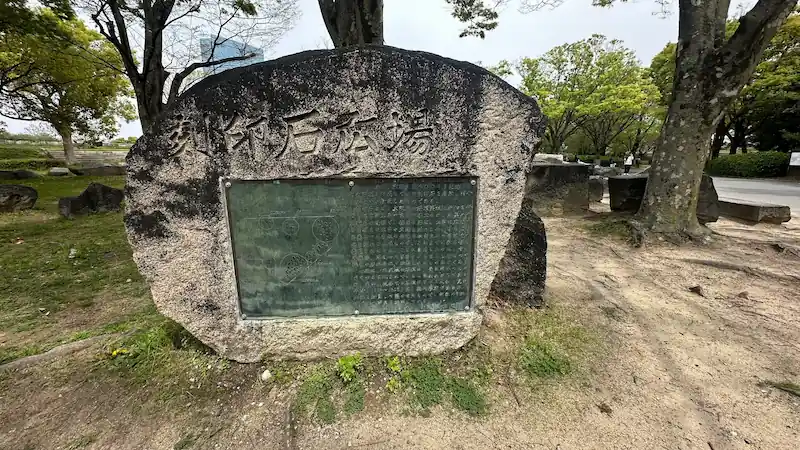
English translation of the image above
This square was established to commemorate the 400th anniversary of Osaka Castle’s construction, specifically to exhibit and introduce the engraved stones (“kokuin-ishi”) that form part of its stone walls.
Engraved stones are those marked by samurai retainers and stonemasons working under various daimyo (feudal lords) who participated in building the castle’s stone walls. These inscriptions, made during the collection and stacking process, include characters, symbols, or decorative patterns applied as needed. Additionally, the completed stone walls often featured family crests and other markings identifying the daimyo responsible for their construction. To date, tens of thousands of such engraved stones have been discovered.
The stones exhibited here were recovered from storage sites within the city and riverbanks in the vicinity, as well as from stones removed during restoration work on the castle’s stone walls.
Contrary to the popular belief that Osaka Castle’s stone walls date entirely from the Toyotomi era, all currently existing stone structures were actually constructed during the Genna to Kan’ei eras (1620–1629) by order of the Tokugawa shogunate. Sixty-four domains from western Japan were mobilized to carry out this massive construction project. The countless engraved stones provide tangible proof of this historical fact.
October 1983Osaka Castle Main Tower
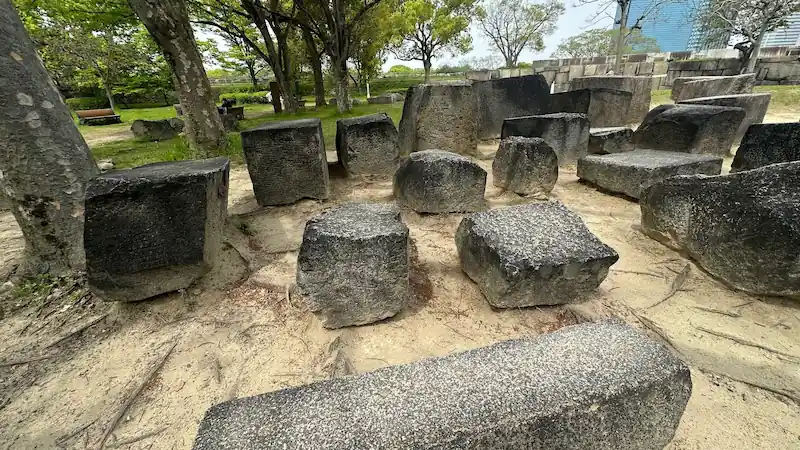
⭐ Recommendation Rating
- Historical Significance: ☆☆
- Visual Appeal: ☆☆
- Experiential Value: ☆☆
Located in the Yamazatomaru section on the northern side of Osaka Castle, the Inscribed Stone Square is a historically rich area that showcases building stones bearing engraved marks from the daimyo lords who took part in Osaka’s reconstruction during the Edo period. Established in 1983 to commemorate the 400th anniversary of the castle’s construction, this open-air exhibit features around 80 stones, displayed according to the excavation area in which they were found.
These inscriptions—symbols, family crests, and characters—were carved by samurai retainers and stonemasons as identifiers during the stone-gathering and wall-building processes. The exhibit offers a direct connection to the people and politics behind the creation of Osaka Castle, revealing the collaborative efforts of feudal lords in shaping this monumental structure.
| Year Built | 1983 (Showa 58), commemorating the 400th anniversary of Osaka Castle |
|---|---|
| Builder | City of Osaka |
| Structure/Features | Open-air exhibit displaying approximately 80 stones with engraved marks from feudal lords; stones are categorized by excavation zones |
| Renovation/Restoration | None; stones are preserved in their discovered state |
| Current Status | Open to the public; located in the Yamazatomaru area on the northern side of Osaka Castle |
| Destruction/Damage | None; stones remain intact as historical artifacts |
| Cultural Property Designation | Not individually designated; part of Osaka Castle Park’s historical landscape |
| Remarks | Engravings include clan crests and symbols from 64 western domains involved in the Tokugawa-era reconstruction; offers insight into Edo-period stone masonry and logistics |
🗺 Location:
1-1 Osakajo, Chuo-ku, Osaka-shi, Osaka Prefecture
🚶 Access:
Approx. 2-minute walk (about 130m) from Hidden Bailey (Kakushi Kuruwa)
⏳ Recommended Visit Duration:
Quick visit: 20 minutes
Detailed exploration: Around 1 hour
📍 Highlights:
🔹 Engraved stones display: About 80 stones categorized by excavation zone, many featuring clan crests and personal marks of the contributing lords
🔹 Stone cutting techniques: Some stones still bear “wedge holes” (called yanata) used during the quarrying process, offering insight into Edo-era craftsmanship
🔹 Seasonal beauty: Cherry blossoms in spring and vibrant foliage in autumn enhance the atmosphere of the site
📌 Trivia:
- Unexpected history: The stone walls of Osaka Castle were constructed under Tokugawa shogunate orders, with 64 western clans mobilized—each inscription is proof of this massive collaborative effort
- Insider insight: The stones are arranged according to the zones where they were unearthed, providing clues to which regions contributed specific parts of the fortress
- Famous connection: The engraved crests on these stones represent the daimyo who took part in the Tokugawa-led reconstruction, serving as a rare record of their political and logistical roles in shaping one of Japan’s greatest castles
Site of Seppuku of Toyotomi Hideyori and Lady Yodo

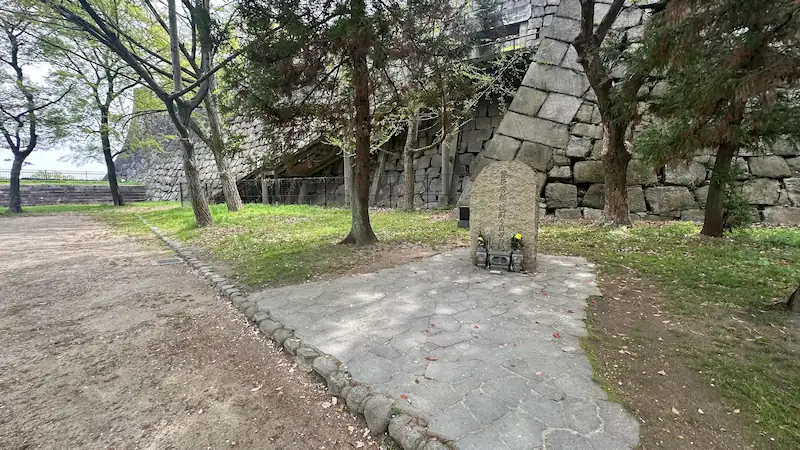
⭐ Recommendation Rating
- Historical Significance: ☆☆☆
- Visual Appeal: ☆☆
- Experiential Value: ☆☆
🏛 Overview
Osaka Castle holds countless dramatic chapters in its history, but few are as poignant as the final moments of Toyotomi Hideyori and his mother, Lady Yodo. On May 8, 1615, during the Summer Siege of Osaka, the Toyotomi forces were cornered by the Tokugawa army. Hideyori and Lady Yodo are believed to have taken refuge in a turret within the Yamazatomaru compound and ultimately took their own lives.
To honor this tragic end, the City of Osaka erected a monument in 1997 at the site known as the Place of Seppuku of Toyotomi Hideyori and Lady Yodo. This solemn marker serves as a poignant reminder of a pivotal moment in Japanese history and continues to draw visitors and history enthusiasts from around the world.
Lady Yodo, a prominent figure bridging the Sengoku and early Edo periods, was a concubine of Toyotomi Hideyoshi. Her father was the warlord Azai Nagamasa, and her mother, Oichi, was the sister of Oda Nobunaga. After giving birth to Hideyori, she became his guardian following Hideyoshi’s death and resided with him in Osaka Castle. Their fate was sealed in the wake of the Tokugawa victory at the Summer Siege.
Visiting this site offers a profound sense of the Toyotomi clan’s rise and fall—and the transience of power during the age of warring states. The monument stands quietly as a witness to history, inviting reflection on a vanished era.
| Year | 1615 (Keichō 20) |
|---|---|
| Event | Seppuku (ritual suicide) of Toyotomi Hideyori and his mother, Lady Yodo |
| Location | Yamazato-maru compound, Osaka Castle |
| Structure/Features | Monument erected in 1997 by the City of Osaka to commemorate the event |
| Current Status | Accessible to the public; located within Osaka Castle Park |
| Destruction/Damage | Original structures destroyed during the Siege of Osaka; monument remains intact |
| Cultural Property Designation | Not individually designated; part of Osaka Castle Park’s historical landscape |
| Remarks | Marks the end of the Toyotomi clan; significant historical site within Osaka Castle |
🗺 Location:
1-1 Osakajo, Chuo-ku, Osaka-shi, Osaka Prefecture
🚶 Access:
Approx. 1-minute walk (about 50m) from Inscribed Stone Square (Kokuinseki Hiroba)
⏳ Recommended Visit Duration:
Quick stop: 20 minutes
In-depth visit: Around 1 hour
📍 Highlights:
🔹 Monument to Hideyori and Lady Yodo: Installed by the City of Osaka in 1997, this monument marks the spot where the Toyotomi heirs met their end, and it continues to draw reverent visitors.
🔹 Nearby Inscribed Stone Square: A short walk away, this area features engraved stones used in the castle’s construction—silent witnesses to the era’s turbulent history.
🔹 Seasonal charm: In spring, cherry blossoms bloom around the site; in autumn, vivid foliage creates a reflective backdrop—each season offering a unique experience of history.
📌 Trivia:
- Surprising backstory: After their defeat in the Summer Siege, Hideyori and Lady Yodo reportedly pleaded for their lives—but were denied, leading to their tragic decision.
- Hidden gem: Near the main monument is the Chureito Memorial Tower, honoring 32 loyal retainers who chose to die alongside Lady Yodo, a testament to feudal loyalty and sacrifice.
- Historical connection: Toyotomi Hideyori, born to Hideyoshi and Lady Yodo, spent his youth within Osaka Castle’s walls. Visiting the site of his death offers a powerful sense of the Sengoku era’s close—and the dawn of a new age.
Gokurakubashi Bridge
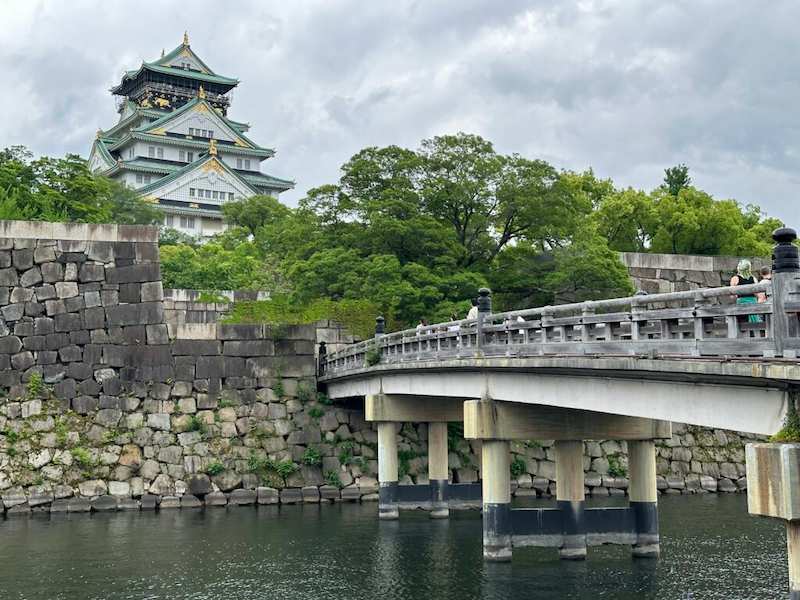
⭐ Recommendation Rating
- Historical Significance: ☆☆
- Visual Appeal: ☆☆☆
- Experiential Value: ☆☆
🏛 Overview
Located on the northern side of Osaka Castle, Gokurakubashi (literally “Bridge to Paradise”) connects the inner Honmaru area with the secondary Ninonomaru enclosure. Its name is derived from “Gokuraku Jōdo,” the Buddhist concept of the Pure Land, and evokes a spiritual and serene atmosphere. The bridge is said to have been originally constructed by Toyotomi Hideyoshi in 1583, shortly after the castle’s founding, and later rebuilt in 1626 during the Tokugawa period.
The current structure, reconstructed in 1965 using reinforced concrete, retains the charm of the original with its traditional ornamental railings (gibōshi kōran). Its rich historical roots and picturesque views continue to make it a favorite among visitors and photographers alike.
| Year Built | Originally constructed in 1626; current structure rebuilt in 1965 |
|---|---|
| Builder | Tokugawa Shogunate |
| Structure/Features | 54-meter-long pedestrian bridge with traditional wooden railings and reinforced concrete supports; spans the inner moat, connecting the Yamazato-maru and Ni-no-maru areas |
| Renovation/Restoration | Rebuilt in 1965 after destruction during the Boshin War in 1868; designed to harmonize with the historical landscape |
| Current Status | Fully restored and accessible to the public; offers panoramic views of Osaka Castle and its surroundings |
| Destruction/Damage | Destroyed by fire during the Boshin War in 1868 |
| Cultural Property Designation | Not individually designated; part of Osaka Castle Park’s historical landscape |
| Remarks | Known as “Paradise Bridge” (Gokuraku-bashi), the name reflects the serene beauty of the area and its historical significance |
🗺 Location:
1-1 Osakajo, Chuo-ku, Osaka-shi, Osaka Prefecture
🚶 Access:
Approx. 15-minute walk (about 1.2 km) from Site of Seppuku of Toyotomi Hideyori and Lady Yodo
⏳ Recommended Visit Duration:
Quick visit: 20 minutes
Leisurely stroll: Around 1 hour
📍 Highlights:
🔹 Bridge structure: Spanning 54 meters in length and 5.4 meters in width, the bridge is built of reinforced concrete, yet adorned with traditional Japanese ornamental railings, preserving its historic ambiance.
🔹 Scenic views: From Gokurakubashi, you can enjoy panoramic views of Osaka Castle’s main keep and the surrounding inner moat—an excellent spot for photography and quiet contemplation.
🔹 Seasonal beauty: In spring, the area becomes a vibrant hanami (cherry blossom viewing) spot. In autumn, colorful leaves frame the bridge, creating a picture-perfect seasonal scene.
📌 Trivia:
- Historical surprise: The original Gokurakubashi, said to have been built in 1596, was praised for its beauty by Jesuit missionary Luís Fróis, who chronicled Japanese history during the period.
- Hidden detail: Some architectural elements from the original bridge were reportedly relocated to Hōgon-ji Temple on Chikubu Island in Shiga Prefecture—adding another layer to its historical legacy.
- Famous figures: The reconstruction and legacy of Gokurakubashi are tied to major historical figures such as Toyotomi Hideyoshi, his wife Nene (Kita no Mandokoro), and Tokugawa Ieyasu—each leaving their mark on this symbolic structure.
Remains of the North Partition Gate

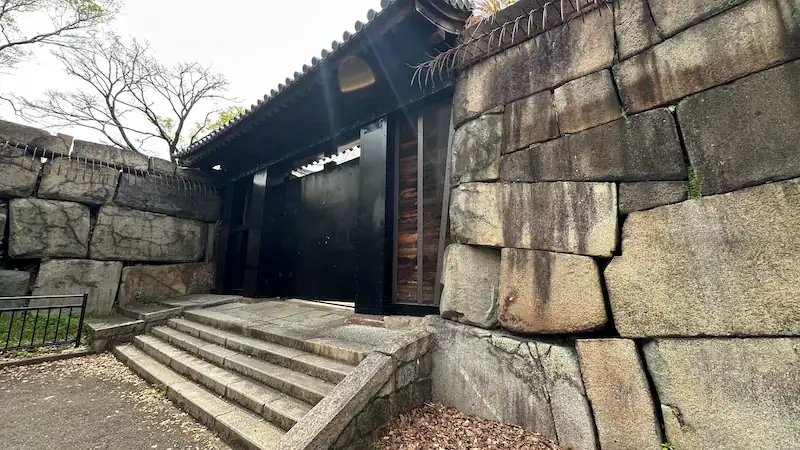
⭐ Recommendation Rating
- Historical Significance: ☆☆
- Visual Appeal: ☆☆☆
- Experiential Value: ☆☆
🏛 Overview
The Remains of the North Partition Gate of Osaka Castle are located on the castle’s northern side and once served as a key defensive and passageway structure. This gate was established during the Edo-period reconstruction of Osaka Castle and played a crucial role as a divider between the North Outer Bailey (Sannomaru) and the Second Bailey (Ninomaru). However, the original gate was destroyed in a fire following the Meiji Restoration, and the structure currently standing—rebuilt in 1963 (Showa 38)—differs significantly from the original Edo-period design.
The gate occupies a historically important position in understanding the Tokugawa-era defense system of Osaka Castle. It formed part of the northern defensive line, protecting against potential incursions from that direction. Surrounding the gate are remnants of Edo-period stone walls and moats, which continue to convey the architectural techniques and military strategies of the time.
While the North Partition Gate is generally closed to the public, it is occasionally opened for special events or ceremonies held at the Nishinomaru Garden. These rare openings provide a unique opportunity to closely observe the gate’s internal structure and surrounding features, offering a tangible sense of the castle’s historical atmosphere.
As such, the Remains of the North Partition Gate are a valuable historical site for learning about the castle’s defense systems and make for a rewarding destination for history enthusiasts.
| Year Built | 1628 (Kan’ei 5) |
|---|---|
| Builder | Tokugawa Shogunate |
| Structure/Features | Remains of a masugata-style gate structure located on the northern side of Osaka Castle; comprised multiple gates arranged in a defensive square layout |
| Renovation/Restoration | Stone foundations remain; no major restorations but preserved as historical ruins |
| Current Status | Only stone remnants remain; accessible to visitors within Osaka Castle Park |
| Destruction/Damage | Original wooden structures lost over time due to wars and modernization |
| Cultural Property Designation | Not individually designated; part of the broader Osaka Castle historical area |
| Remarks | One of several gates forming the complex defensive system of Osaka Castle during the Edo period |
🗺 Address:
Osaka Castle 2-2, Chuo Ward, Osaka, Osaka Prefecture
🚶 Access
Nearest Station: Approximately a 10-minute walk (about 0.8 km) from Gokurakubashi Bridge
⏳ Suggested Visit Duration
- Quick visit: Around 15 minutes
- In-depth exploration: About 1 hour
📍 Highlights
🔹 Reconstructed North Partition Gate: Rebuilt in 1963, this gate, while differing from the original Edo-period design, still evokes the defensive structure of that era.
🔹 Surrounding Stone Walls and Moats: Edo-period stonework and moats remain in the area, offering a glimpse into historical Japanese castle-building techniques and strategic defense layouts.
🔹 Access to Nishinomaru Garden: During special events, visitors can pass through the North Partition Gate to enter Nishinomaru Garden, enjoying views and areas typically inaccessible to the public.
📌 Trivia
- Surprising Historical Detail: Though the original gate was lost in a post-Meiji Restoration fire, the reconstructed gate from 1963 differs from its Edo-era counterpart.
- Hidden Gem: The North Partition Gate is usually off-limits, but it opens during select events or celebrations at Nishinomaru Garden—offering a rare look inside.
- Connection to Historical Figures: Nearby stands Hokoku Shrine, dedicated to Toyotomi Hideyoshi, allowing visitors to reflect on the legacy of one of Japan’s most influential historical leaders.
Higo Stone
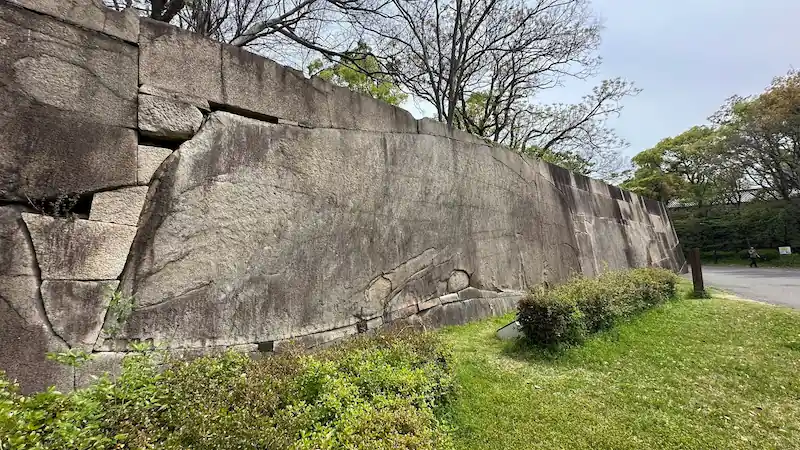
⭐ Recommendation Rating
- Historical Significance: ☆☆
- Visual Appeal: ☆☆☆
- Experiential Value: ☆☆
🏛 Overview
Towering in the Masugata (box-shaped fortification) of the Kyobashi Gate at Osaka Castle, the Higo Stone is recognized as the second-largest monolith within the castle grounds. With a surface area of approximately 54.17 square meters—roughly the size of 33 tatami mats—its sheer scale is nothing short of awe-inspiring. Though long believed to have been transported by Kato Kiyomasa, the powerful lord of Higo Province (modern-day Kumamoto), it was later revealed that the stone was actually brought and installed by Ikeda Tadakatsu, the feudal lord of Okayama, from Shodoshima Island in Sanuki Province.
The grandeur of the Higo Stone reflects the Tokugawa shogunate’s policy of tenka fushin—a nationwide public works campaign in which regional lords competed to contribute massive stones for the castle’s construction, showcasing both loyalty and financial strength. As a result, the Higo Stone became a lasting symbol of Osaka Castle’s power and prestige.
Visitors standing before this colossal stone can tangibly sense the political weight and advanced stonework techniques of the transition from the Sengoku to the Edo period. The Higo Stone remains one of Osaka Castle’s hidden gems—a silent yet powerful testament to the passion and ambition of a bygone era.
| Year Built | Circa 1620s (Edo period) |
|---|---|
| Builder | Ikeda Tadakatsu, feudal lord of Himeji |
| Structure/Features | Massive granite monolith measuring approximately 54.17 square meters (about 48 feet long and 19 feet high); part of the Kyōbashiguchi masugata (box-shaped fortification) |
| Renovation/Restoration | Original placement; no significant restorations recorded |
| Current Status | Intact and prominently displayed within Osaka Castle Park |
| Destruction/Damage | None; preserved in its original state |
| Cultural Property Designation | Not individually designated; part of Osaka Castle Park’s historical landscape |
| Remarks | Initially believed to have been transported by Katō Kiyomasa; later research attributes it to Ikeda Tadakatsu from Shōdoshima Island; exemplifies the Tokugawa shogunate’s policy of tenka fushin (nationwide public works) and the competitive contributions of feudal lords |
🗺 Location:
1-1 Osakajo, Chuo-ku, Osaka-shi, Osaka Prefecture
🚶 Access:
Approx. 2-minute walk (about 140m) from Remains of the North Partition Gate
⏳ Recommended Visit Duration:
Quick stop: 20 minutes
In-depth visit: Around 1 hour
📍 Highlights:
🔹 Monumental presence: Positioned within the Kyobashi Gate’s masugata, the Higo Stone impresses with its massive size and smooth, commanding surface.
🔹 History carved in stone: The surrounding walls, including the Higo Stone, are embedded with engraved marks from feudal lords who participated in the construction, serving as lasting records of historical contributions.
🔹 Seasonal appeal: Cherry blossoms in spring and colorful autumn foliage provide a stunning natural frame, enhancing the stone’s timeless appeal throughout the year.
📌 Trivia:
- Surprising origins: Contrary to popular belief, the Higo Stone was not transported by Kato Kiyomasa, but by Ikeda Tadakatsu from Shodoshima Island.
- Hidden craftsmanship: Beneath the stone, iron wedges were embedded to stabilize it—an ingenious example of the construction techniques used at the time.
- Historical connection: Ikeda Tadakatsu played a key role in this project as part of a large-scale Tokugawa building initiative aimed at showcasing the shogunate’s authority.
Aoya Gate
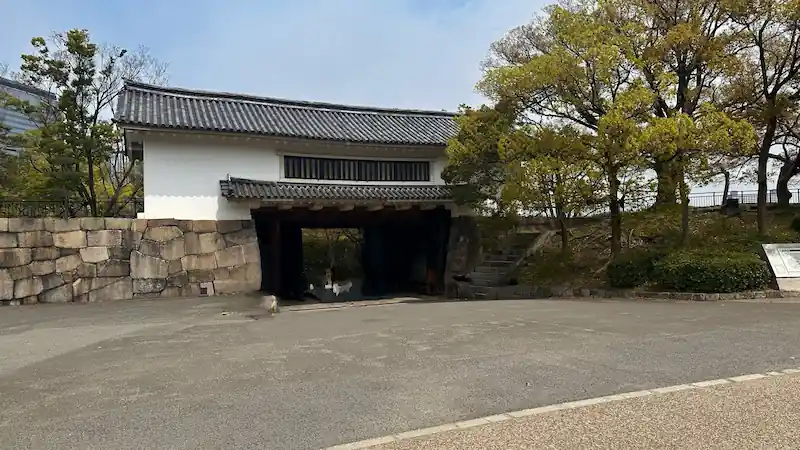
⭐ Recommendation Rating
- Historical Significance: ☆☆☆
- Visual Appeal: ☆☆☆
- Experiential Value: ☆☆
🏛 Overview
Situated in the northeastern quadrant of Osaka Castle, the Aoya Gate stands as one of the primary entrances to the Ni-no-maru (secondary enclosure). Constructed in 1620 as part of the Tokugawa shogunate’s major reconstruction efforts, the gate embodies Edo-period military architecture. It features a masugata—a square defensive courtyard—and a distinctive demasugata, an extended section designed to increase defensive capabilities by trapping invading forces.
The name “Aoya” is believed to have originated from Aoyamachi, a town once located here during the Sengoku period as part of the Osaka (Ishiyama) Honganji temple complex. “Aoya” also refers to dyeworkers, hinting at the town’s artisan heritage.
The Aoya Gate suffered significant damage twice in its history—first during the Meiji Restoration and again during World War II air raids. What visitors see today is a reconstruction completed in 1969 by the City of Osaka, using original materials where possible. The gate now serves as a testament to both historical preservation and the resilience of cultural heritage.
| Year Built | Circa 1620 (Genna 6), during Tokugawa shogunate reconstruction |
|---|---|
| Builder | Engineers under the Tokugawa shogunate |
| Structure/Features | Yaguramon-style gate within a protruding masugata enclosure; featured a retractable “Soroban-bashi” bridge over the moat |
| Renovation/Restoration | Damaged during the Meiji Restoration; rebuilt by the military; destroyed in 1945 air raids; reconstructed in 1969 using remaining materials |
| Current Status | Reconstructed gate with restored features; designated as a historical structure within Osaka Castle Park |
| Destruction/Damage | Severely damaged during the 1945 air raids in World War II |
| Cultural Property Designation | Not individually designated; part of Osaka Castle Park’s historical landscape |
| Remarks | Named after the historical Aoya-chō area; considered a “kimon” (demon gate) due to its northeastern position and was typically kept closed during the Edo period |
🗺 Location:
1-1 Osakajo, Chuo-ku, Osaka-shi, Osaka Prefecture
🚶 Access:
Approx. 7-minute walk (about 550m) from Higo Stone
⏳ Recommended Visit Duration:
Quick stop: 15 minutes
Extended exploration: Around 45 minutes
📍 Highlights:
🔹 Gate structure: The Aoya Gate is a tower gate (yaguramon) located within a masugata enclosure, featuring the rare demasugata extension that exemplifies Edo-period defensive strategy.
🔹 Soroban Bridge site: Just outside the gate once stood a retractable bridge known as the Soroban-bashi. While the bridge itself no longer exists, its foundations remain visible, hinting at the castle’s tactical ingenuity.
🔹 Seasonal charm: The area around the Aoya Gate is particularly beautiful in spring and autumn, when cherry blossoms and autumn foliage transform the historic site into a scenic wonder.
📌 Trivia:
- Unexpected history: During the Edo period, the Aoya Gate was considered a “kimon” (demon gate) due to its northeastern location and was typically kept closed to ward off misfortune.
- Insider tip: Nearby viewpoints offer a close-up of Osaka Castle’s high stone walls, making this a prime spot for photography and castle enthusiasts.
- Historical figures: The reconstruction of the Aoya Gate involved contributions from multiple feudal domains under Tokugawa rule, reflecting both the architectural and political systems of the time.
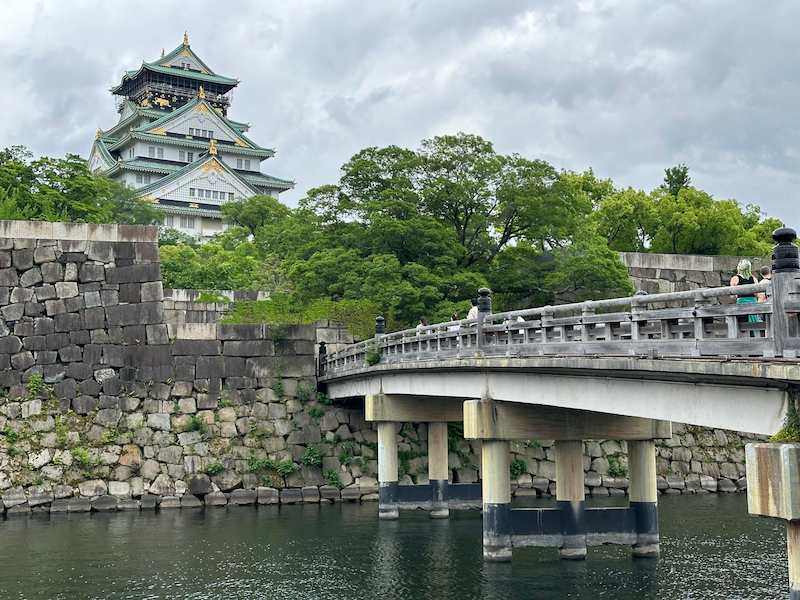


comment